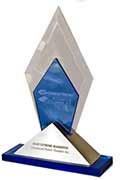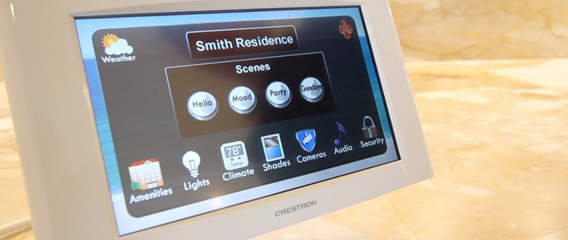Residential integrators may finally be getting comfortable branching out into one of the most profitable categories available–shade and lighting control–just as the category sees its own growth with new integration strategies. Homeowners that previously may not have understood the benefits beyond aesthetics and basic energy management may now see additional conveniences as shade and control systems integrate with security systems.
Eric Dickson, a designer at AHT Residential in Miami, FL, recently created a fully functional automation system in a decked-out sales center model condo in Sunny Isle Beach, FL. The sales center model–a 4,000-square-foot space with the “latest and greatest” technology–will allow AHT Residential to pitch full Crestron automation, including lighting and shades control.
Lighting and Shades in Every Pitch
Eric Dickson, a designer at AHT Residential in Miami, FL, recently created a fully functional automation system in a decked out sales center model condo. Dickson said that the apartment, while functioning as a demo space, is as real and luxurious as those in the two new high-rise condos it will be helping to sell. The Mansions at Acqualina and the Porsche Design Tower–both located in Sunny Isle Beach, FL, are luxurious testaments to Miami’s booming condo scene. The sales center apartment–a 4,000-square-foot space with the “latest and greatest” technology–will allow AHT Residential to pitch a full Crestron automation system to each and every new condo-owner.
With every condo pre-wired for Crestron control, and an amenities smart panel that comes standard, Dickson is expecting the intuitive convenience of touchpanel control to help make the full sale to homeowners.
“It’s second nature now, there’s no learning curve,” Dickson said.
Dickson says that he makes the case for shade and lighting control with every new pitch. “I always talk to a potential client about all the technology we can offer them. It’s my job to educate them about all the different service–our mission statement is enhancing your lifestyle with cutting-edge technology.”
Conserving energy will likely remain the key selling point for lighting and shades control, but the many side benefits may not be immediately evident to homeowners that are only considering the benefits of home control for the first time.
“Lighting and shades control will help protect their furnishings and artwork,” Dickson said, noting that protecting such valuable possessions from the sun is particularly relevant for the high-end clients luxury condos are courting.
Pairing Lighting and Security
Jeremy Kleinberg, product manager of residential systems for Lutron, also sees benefits from the pairing of total light control with other technology categories, like home security. Rather than adding an extra step to a homeowner’s routine, lighting and shades control can integrate with existing habits.
“Automatically controlling lights and shades as part of their everyday security routine adds energy-saving and convenience benefits that the customer will use every day,” Kleinberg said. “For instance, when they arm their system to leave for the evening, the system can turn off lights and appliances, close the shades, and set back the thermostat to an energy-saving set point. Customers really light up when they learn that they will enjoy enhanced ambiance, convenience, and security while saving energy.”
Kleinberg noted that Lutron has adapted to changes in lighting technology with its own advances, such as an adaptive dimmer for its HomeWorks QS and RadioRA 2 systems.
“On the shades side, our Sivoia QS Wireless insulating honeycomb shades remove all barriers for any integrator interested in adding shades to their product offering. Their battery-powered design and the use of Lutron’s Clear Connect RF communication means there are no wires to run,” Kleinberg said. “They install in minutes using simple, easy-to-mount brackets.”
Lutron’s adaptive dimmer automatically adjusts to provide optimal control of incandescent, magnetic and electronic low voltage, as well as approved, dimmable LED lamps.
Residential custom integrators are now realizing the security and energy saving aspects of lighting control in addition to its aesthetic appeal, said Greg Rhoades, associate director of marketing at HAI.
“Homeowners love the ability to turn all lights off automatically when typing in their security code on the way out the door,” Rhoades said. “They love being on vacation and switching up a few lights for a lived-in appearance, or using their iPad from their bed to open the window coverings.”
“Many installers are using lighting control just for creation of ambiance. However, lighting is the number-one proven deterrent to crime, so HAI makes sure that when an alarm occurs, all lights automatically activate, and the exterior lights can even flash to alert emergency vehicles.”
While HAI manufactures two lighting control product lines, the company’s home control system can integrate with over a dozen other lighting manufacturers. “Working together ensures that the homeowner gets the exact control necessary or allows an HAI home automation panel to integrate with an existing lighting control system,” Rhoades said.
He suggested that as dealers push lighting control–with “growth occurring in part thanks to better technology which can control LED, CFL, etc.”–they also need to cover natural lighting control and educate the homeowner.
Training is the Key
“We believe that custom integrators are indeed deploying more technology to their customer base outside of home theater and AV packages, and in reality, a considerable amount have been doing so for quite some time,” said Paul McInally, director, product development for 3vNet (formerly Colorado vNet). “The availability– and more importantly the reliability–of wireless communications co-existing in a home have improved tenfold. More installers are comfortable deploying wireless products, with lighting products being a leading application.”
Yet, despite those factors, McInally believes that lighting control systems are still being undersold. “The primary reason is deployment,” he explained. “Basically it’s a deficiency in training. That’s an industry service that we must all improve. Training should encompass everything from the selection of lighting fixtures, to layout and design, to spatial concepts, and even the art of creating moods and scenes with light.”
McInally said that 3vNet’s focus is on systems that are easy and quick to install. “Our software comes with a great feature that works as a sales and marketing tool–a built-in simulator that provides the end-user with a visual overview of how the system will work,” he explained. “A great advantage to this is that the set-up becomes the configuration of the system.”
3vNet is introducing a wireless outlet switch that will allow a regular wall outlet to be converted to a control device. “It’s an easy way to add simple lighting loads like desk lamps or other consumer devices to a controlled system,” McInally said.
Increased simplicity and ease of use for both dealers and consumers will continue to have a positive impact on the lighting control segment, added Jim Carroll of Savant. “Savant has already made great strides with advances such as TrueImage Control and the development of customizable and stylish LiteTouch keypads, however, more options for the end-user will drive interest and excitement,” he said. “Lighting control remains one of the most profitable categories for integrators.”
Article provided by Derek Dellinger, web editor for Residential Systems.






